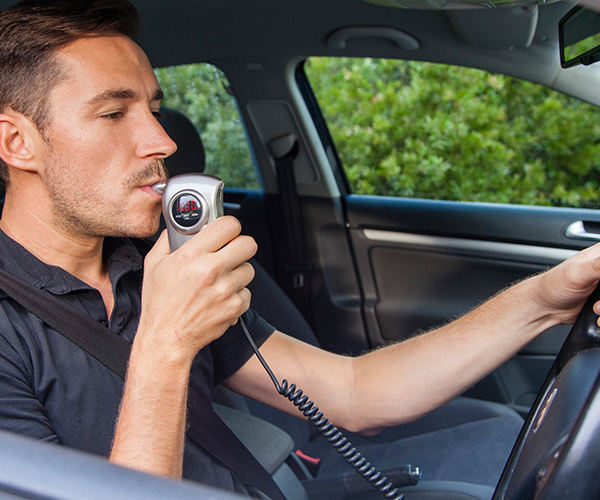After getting an Operating While Intoxicated (OWI) conviction in Wisconsin, the court often required the instillation of an ignition interlock device (IID), often referred to as car breathalyzers. These devices require the use of a breathalyzer to determine the user's BAC before it allows the car to start, and they require breath samples throughout driving as well.
After getting an OWI, one common requirement imposed by the courts and the Wisconsin Department of Transportation (WisDOT) is the installation of an Ignition Interlock Device (IID), often referred to as a car breathalyzer. This article aims to provide a clear and comprehensive overview of car breathalyzers and IIDs in Wisconsin for prospective clients facing these challenging circumstances.

Car Breathalyzers & Ignition Interlock Devices (IIDs)
An Ignition Interlock Device is essentially a breathalyzer installed in a vehicle that is directly connected to the ignition system. Before the vehicle can be started, the driver must blow into the device. If the device detects a breath alcohol concentration (BrAC) above a pre-set limit the vehicle will not start. That limit is 0.02% alcohol after one OWI, but it is 0.00% after receiving any subsequent OWI offenses in Wisconsin.
Beyond the initial breath test, IIDs in Wisconsin also require "rolling retests" at random intervals while the vehicle is being operated. This means the driver will be prompted to provide another breath sample while driving. If a sample is not provided or if alcohol is detected, the device will typically log a violation, and in some cases, may activate the vehicle's horn and lights until the vehicle is turned off.
The purpose of IIDs is to prevent individuals convicted of drunk driving offenses from operating a vehicle while impaired. These devices serve as a monitoring tool, ensuring compliance with court orders and WisDOT regulations regarding alcohol-restricted driving. Understanding the basics of IIDs is the first step in addressing the requirements you may be facing.
How Car Breathalyzers Work
The technology behind car breathalyzers is relatively straightforward. Below is a breakdown of the process.
Breath Sample Collection: When prompted, the driver must provide a breath sample by blowing into the mouthpiece of the IID for a few seconds. The device analyzes the breath sample to determine the alcohol concentration.
BAC Analysis: The IID uses a sensor to measure the amount of ethanol (alcohol) present in the breath. This measurement is then converted into a Breath Alcohol Content (BrAC) reading.
Ignition Control: If the measured BrAC is below the pre-set limit, the IID will allow the vehicle’s ignition to engage, and the driver can start the car. If the BrAC is at or above the limit, the vehicle will be prevented from starting.
Rolling Retests: After the vehicle has been started, the IID will periodically prompt the driver to provide a "rolling retest." This is a safety measure to ensure that the driver has not consumed alcohol after starting the vehicle. The prompts are typically a combination of audible and visual signals. The driver has a short window of time to provide the sample.
Violation Recording: If a rolling retest is missed, or if a sample with a BrAC above the limit is detected during a rolling retest, the IID will record a violation. These violations are typically reported to the monitoring authority (either the court or WisDOT) and can lead to penalties, such as extending the IID requirement.
Data Logging: All activity of the IID is logged by the device, including start-up attempts, BrAC readings, missed tests, and rolling retests. This data is periodically downloaded by the IID service provider and transmitted to the relevant authorities for monitoring compliance.
It's crucial to understand that attempting to tamper with or circumvent an IID is a serious offense in Wisconsin and can result in significant penalties, including further license suspension or revocation, additional fines, and possibly jail time.
Legal Requirements of an Ignition Interlock Device
Navigating the complexities of OWI laws and IID requirements in Wisconsin can be overwhelming. Understanding your obligations and rights is crucial. If you or someone you know is facing drunk driving charges and potential IID requirements, it is essential to seek legal counsel from an experienced Wisconsin law firm. We can help you understand the specific requirements of your case, explore any potential options or exceptions, and guide you through the process of regaining your driving privileges. Contact us today for a consultation to discuss your situation.

Obtaining and Paying for an Ignition Interlock
If you are required to install an IID in Wisconsin, you will need to work with an approved IID service provider. WisDOT maintains a list of certified providers operating in the state. You will be responsible for contacting a provider, scheduling the installation of the device in any vehicle you own or operate, and paying all associated costs.
The costs associated with an IID can include:
Installation Fee: A one-time fee charged for installing the device in your vehicle.
Monthly Lease/Service Fee: A recurring fee that covers the lease of the device, data monitoring, and calibration.
Calibration Fees: Periodic calibration of the device is required to ensure accuracy.
Removal Fee: A fee charged for removing the device at the end of the required period.
The total cost of an IID over the required period can be substantial. It is essential to factor these expenses into your budget. Payment arrangements may vary between providers, so it's advisable to inquire about payment options when selecting a service provider. Failure to pay for the IID services can lead to further penalties and prevent you from fulfilling the requirements for license reinstatement.
Cost-Reduction Option: You can petition the court for a 50% reduction in the cost of installing and maintaining an IID on your vehicle if your household income is at or below 150% of the federal poverty guidelines.
Ignition Interlock Time Requirements
The duration you will be required to have an IID installed in your vehicle in Wisconsin depends on several factors, primarily the number of prior drunk driving convictions (OWI - Operating While under the Influence) and your BAC at the time of the offense.
First OWI Offense: If your BAC was 0.15% or higher, an IID will be required for a period of 12 months.
Second OWI Offense: An IID is typically required for a period of 12 to 18 months.
Third OWI or Subsequent OWI Offenses: The IID requirement can range from one to three years, or even longer, depending on the specific circumstances and the court's order. The IID requirement typically mirrors the length of driver’s license revocation that the court orders.
It's important to note that these are general guidelines, and the specific duration of the IID requirement will be determined by the court and WisDOT based on the details of your case. Violations of the IID requirements, such as attempting to drive a vehicle not equipped with an IID or tampering with the device, can at a minimum extend the period for which you are required to have the device installed and at a maximum lead to additional criminal charges for which you could go to jail.
Who Has to Use Ignition Interlock Devices
In Wisconsin, IID installation is often a mandatory requirement for individuals convicted of certain OWI offenses. Generally, the following individuals will be required to install and maintain an IID:
- Individuals convicted of a second or subsequent OWI offense.
- Individuals convicted of a first OWI offense with a BAC of 0.15% or higher.
- Individuals who are convicted of refusing to submit to a chemical test (breath, blood, or urine) after being arrested for OWI, even if it is their first offense.
- Individuals whose licenses have been reinstated after a revocation period related to an OWI offense, as a condition of their restricted or full driving privileges.
The specific circumstances of your case, including your prior record and BAC level, will determine whether an IID is required. It is crucial to understand the court order and WisDOT requirements specific to your situation.
Exceptions to Ignition Interlock Devices
While IIDs are a common requirement in Wisconsin OWI cases, there are limited exceptions. Exceptions to getting an IID are typically granted under specific and narrow circumstances. Some potential exceptions might include:
Multiple Vehicles: You may petition the Court for an order exempting you from the requirement of having an IID installed in every vehicle owned by you or registered in your name. However, whether an exemption is granted is up to the discretion of the judge.
Out-of-State Residence: If you are a resident of another state and are convicted of an OWI in Wisconsin, the requirements for IID installation might differ based on your home state's laws and any agreements between the states. However, Wisconsin may still impose restrictions on your driving privileges within the state, and those restrictions could be effective permanently.
It is important to understand that these exceptions are not guaranteed and are evaluated on a case-by-case basis. You will likely need to petition the court or WisDOT and provide compelling evidence to support your request for an exception.
Occupational Licenses
For individuals facing a driver's license suspension or revocation due to an OWI offense, an occupational license (also known as a hardship license) may be available. An occupational license allows limited driving privileges for essential purposes, such as getting to and from work, school, or medical appointments.
Where an IID is required as a condition of license reinstatement, it will also be a requirement for obtaining an occupational license.
The requirements for obtaining an occupational license in Wisconsin include a waiting period of 45 days after the initial revocation for second and subsequent OWI offenses, proof of financial responsibility (SR-22 insurance), an alcohol and other drug awareness (AODA) assessment, and potentially the installation of an IID. The availability and conditions of an occupational license will depend on the number of prior OWI offenses and the specifics of your case.

